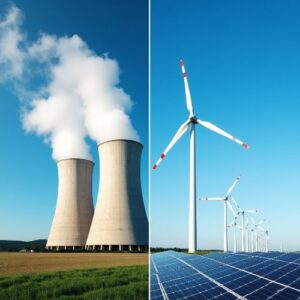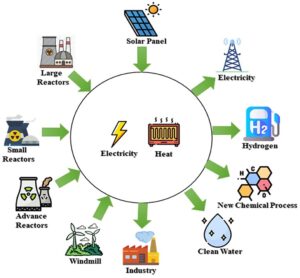Nuclear Energy Grid Stability: Why Renewables Alone Aren’t Enough
Lessons from the 2025 Iberian Peninsula Blackout
The future of grid stability: Nuclear power working alongside renewable energy sources

On April 28, 2025, the Iberian Peninsula experienced one of the most significant power outages in recent European history. The blackout, which began at 12:33 CEST, lasted approximately ten hours and affected millions across mainland Portugal, peninsular Spain, Andorra, and parts of southwest France. The sudden loss of power led to widespread disruptions in telecommunications, transportation systems, and essential services. Tragically, at least eight fatalities were reported, primarily due to candle fires and generator exhaust fumes.
As an energy professional, I find this event particularly compelling because it exemplifies the challenge of maintaining nuclear energy grid stability while transitioning to cleaner systems.
📉 What Actually Happened?
According to grid operator Red Eléctrica de España, the blackout occurred after around 15 gigawatts (GW) of electricity generating capacity—equivalent to 60% of Spain’s power demand—dropped off the system within just five seconds. At the time, about 70% of grid electricity was being supplied by solar and wind.
While investigations continue, the incident has sparked vigorous debate about grid reliability and the role different generation sources play in maintaining it.
⚙️ The Technical Challenge: Grid Stability with High Renewable Penetration
Traditional electricity grids were built around large, centralized plants—typically coal, gas, or nuclear—which provided both electricity and nuclear energy grid stability through spinning turbines. These turbines acted as “shock absorbers,” smoothing fluctuations between supply and demand.
As Gilles Thonet of the International Electrotechnical Commission explained: “Traditionally, power flowed in one direction: from large coal, gas or nuclear plants to homes and businesses. These plants provided not only electricity, but also stability.”
A major challenge with high renewable penetration is “system inertia”—the grid’s natural resistance to frequency changes. Conventional plants provide inertia through their rotating mass. Wind and solar, by contrast, typically connect via electronics and don’t offer the same stabilizing effect.
☢️ The Role of Nuclear in a Renewable-Heavy Grid
Spain generated nearly 57% of its electricity in 2024 from renewable sources and about 20% from nuclear. The country plans to decommission its remaining reactors between 2027 and 2035 while expanding renewables to 81% by 2030.
However, the blackout has reignited the debate over this phase-out plan:
Arguments for Nuclear as a Stabilizing Force:
- Grid Inertia: Nuclear adds essential inertia to the grid, stabilizing frequency where most renewables cannot.
- Reliable Baseload: Nuclear plants operate regardless of weather, complementing intermittent sources like wind and solar.
- Carbon-Free Generation: Like renewables, nuclear produces zero direct emissions and aligns with climate targets.
Spain’s nuclear lobby, Foro Nuclear, has urged the government to reconsider its exit plan, arguing that nuclear plants “provide firmness and stability” to the grid.
Counter-Arguments:
Spanish Prime Minister Pedro Sánchez rejected claims that more nuclear power would have prevented the blackout. He noted that the four nuclear plants operating before the outage were shut down afterward as part of emergency procedures.
Environment Minister Sara Aagesen added that the grid had already withstood a separate outage just 19 seconds earlier. This suggests that deeper systemic issues were involved.
⚖️ Finding the Right Balance: A Hybrid Approach
The real question isn’t “which source failed?” but “how did each energy source contribute to the outcome?”

An hybrid model, combining nuclear, renewables, and storage may offer the most practical path forward.
An electricity mix that relies heavily on intermittent, asynchronous generation without matching infrastructure invites risk. After the blackout, Spain and Portugal turned to gas-fired turbine plants to restore grid inertia—an option that clashes with long-term climate goals.
A more resilient strategy could include:
- Maintain Nuclear Capacity 🔄: Preserve part of the fleet to provide reliable baseload power and nuclear energy grid stability.
- Expand Renewables Thoughtfully 🌞💨: Grow clean energy sources while upgrading grid technology to support them.
- Invest in Storage 🔋: Use batteries and other tools to buffer power fluctuations.
- Develop Synthetic Inertia 💻: Explore new tech that mimics the stabilizing effects of conventional plants.
💡 Conclusion: Pragmatism Over Ideology
The Iberian Peninsula blackout reminds us how vital a resilient grid really is. As nations push toward clean energy goals, they must weigh reliability just as seriously.
A smart grid— one that combines renewables with nuclear energy grid stability—offers a balanced, pragmatic path forward. While politics will shape the pace of change, the technical case for keeping some nuclear capacity is hard to ignore.
💬 What are your thoughts on nuclear’s role in supporting renewable growth? I’d love to hear your perspective.
Sources: Documentation on the April 2025 Iberian Peninsula blackout, AP News reporting, Carbon Brief analysis, and grid operator statements.



